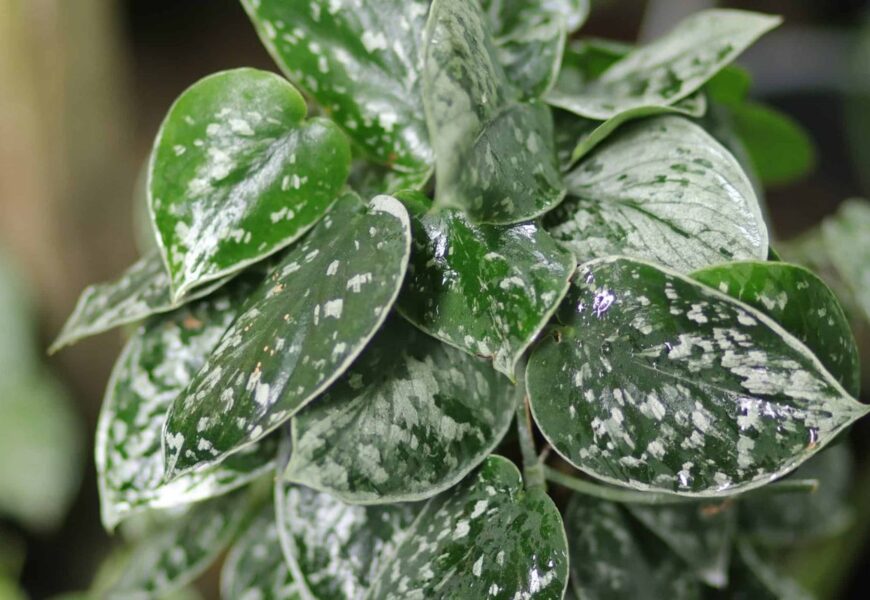White Pothos (Epipremnum aureum) is a popular houseplant known for its striking variegated leaves. Its adaptability, ease of care, and air-purifying properties make it a fantastic addition to any home. Whether you’re new to plant care or an experienced gardener, this guide will walk you through everything you need to know to keep your White Pothos healthy and thriving.
Introduction to White Pothos
White Pothos is admired for its heart-shaped, glossy leaves, which feature a unique mix of white and green variegation. It’s a member of the Epipremnum aureum species and is known for its resilience. This plant is well-suited for both beginners and those who are busy since it thrives in a variety of lighting and watering conditions. Additionally, it’s a natural air purifier, making it a beneficial choice for eco home environments.
Types of Pothos Plants
1.Golden Pothos
Golden Pothos features heart-shaped, glossy green leaves with bright yellow streaks, making it a vibrant addition to any space. It thrives in low light but grows best with bright, indirect sunlight. This low-maintenance plant purifies indoor air and is perfect for beginners.
- Leaf Color: Green with yellow streaks
- Leaf Size: Medium to large, heart-shaped leaves
- Symbols: 🌿 (green), 🌞 (low light tolerance), 🐾 (pet-toxic)
2.Neon Pothos
Neon Pothos has striking neon-green leaves that add a bold splash of color to any room. It thrives in bright, indirect light but can tolerate lower light levels. This variety is easy to care for and requires only occasional watering when the soil dries out.
- Leaf Color: Neon green
- Leaf Size: Medium, heart-shaped leaves
- Symbols: 🌿 (green), 🌞 (bright light), 🐾 (pet-toxic)
3.Marble Queen Pothos
Marble Queen Pothos boasts white and green marbled leaves, offering a sophisticated touch to home interior decor. It grows best in bright, indirect light to maintain its variegation. This variety requires regular watering and a well-draining potting mix to thrive.
- Leaf Color: White and green marbled
- Leaf Size: Medium to large, heart-shaped leaves
- Symbols: 🌿 (green), 🌞 (bright light), 🐾 (pet-toxic)
4.Jade Pothos
Jade Pothos has smooth, dark green, waxy leaves that give it a sleek, minimalist appearance. It grows well in moderate to bright indirect light but can tolerate lower light. The plant is easy to care for, requiring only occasional watering when the top of the soil dries out.
- Leaf Color: Solid dark green
- Leaf Size: Medium to large, waxy heart-shaped leaves
- Symbols: 🌿 (green), 🌞 (moderate light), 🐾 (pet-toxic)
5.Pearls and Jade Pothos
Pearls and Jade Pothos feature delicate green and white variegation, with occasional silver spots. It thrives in medium to bright indirect light, growing slowly compared to other Pothos varieties. Regular watering is needed, ensuring the soil stays slightly moist without becoming waterlogged.
- Leaf Color: Green with white and silver variegation
- Leaf Size: Medium, heart-shaped leaves
- Symbols: 🌿 (green), 🌞 (moderate light), 🐾 (pet-toxic)
6.Cebu Blue Pothos
Cebu Blue Pothos is known for its silvery-blue leaves, creating an elegant, cool-toned aesthetic. It thrives in bright, indirect light but can adapt to lower light, where its color may fade. This variety grows quickly and can be used in hanging baskets or as a climbing plant.
- Leaf Color: Silvery-blue
- Leaf Size: Medium to large, elongated leaves
- Symbols: 🌿 (blue-toned), 🌞 (bright light), 🐾 (pet-toxic)
7.Baltic Blue Pothos
Baltic Blue Pothos features glossy blue-green leaves that add a rich, exotic look to any room. It requires bright, indirect light for the best growth but is adaptable to lower light conditions. Regular watering and a well-draining pot are essential for maintaining its health.
- Leaf Color: Blue-green
- Leaf Size: Medium, glossy heart-shaped leaves
- Symbols: 🌿 (blue-green), 🌞 (bright light), 🐾 (pet-toxic)
8.Snow Queen Pothos
Snow Queen Pothos is known for its white and green marbled leaves, giving it an elegant and ethereal appearance. It thrives in bright, indirect light, which helps it retain its striking variegation. Like other Pothos varieties, it needs occasional watering and a well-draining pot.
- Leaf Color: White and green marbled
- Leaf Size: Medium, heart-shaped leaves
- Symbols: 🌿 (green and white), 🌞 (bright light), 🐾 (pet-toxic)
9.Satin Pothos
Satin Pothos, also known as Scindapsus pictus, has dark green, heart-shaped leaves with silver-gray markings. It grows well in low to moderate light and is perfect for rooms with less natural sunlight. This low-maintenance plant only requires watering when the soil is dry.
- Leaf Color: Dark green with silver-gray markings
- Leaf Size: Medium, heart-shaped leaves
- Symbols: 🌿 (green with silver), 🌞 (low light), 🐾 (pet-toxic)
10.Silver Satin Pothos
Silver Satin Pothos has deep green leaves with shimmering silver markings, giving it a beautiful metallic look. It thrives in bright, indirect light but can tolerate moderate light conditions. This easy-to-care-for plant needs minimal attention and occasional watering.
- Leaf Color: Deep green with silver markings
- Leaf Size: Medium, heart-shaped leaves
- Symbols: 🌿 (green with silver), 🌞 (bright light), 🐾 (pet-toxic)
Ideal Growing Conditions for White Pothos
White Pothos prefers bright, indirect light, though it can tolerate lower light levels, making it suitable for various indoor environments. Direct sunlight can scorch its leaves, so it’s important to place it where it receives filtered light. It thrives in temperatures between 65°F and 85°F (18°C to 29°C), making typical indoor climates ideal. Additionally, White Pothos prefer moderate to high humidity. If your home is dry, consider using a humidifier or misting the plant occasionally to maintain its health.
Watering and Fertilization Tips
Watering is crucial to White Pothos care. The plant should be watered when the top 1-2 inches of the soil feel dry. Overwatering can cause root rot, while underwatering can lead to wilting leaves. During the growing season (spring and summer), White Pothos benefit from monthly feeding with a balanced, water-soluble fertilizer. During fall and winter, when the plant is less active, it requires less frequent feeding. Be cautious not to fertilize too much, as this can lead to nutrient burn.
Pruning and Maintenance
Pruning White Pothos regularly encourages fuller growth and prevents it from becoming too leggy. Trim back any long or sparse vines to promote new shoots and a bushier appearance. You can also remove yellowing or dead leaves to keep the plant looking neat. Wipe the leaves with a damp cloth every so often to remove dust, which helps the plant absorb sunlight and stay healthy. Regular maintenance ensures that your plant stays vibrant and grows consistently.
Propagation Techniques
White Pothos is easy to propagate, which means you can expand your collection or share cuttings with friends. To propagate, take a 4-6 inch cutting with at least one node, the small bump where roots can develop. Place the cutting in water, and within 2-4 weeks, you’ll notice roots forming. Once the roots are established, transplant the cutting into fresh soil. Alternatively, you can propagate directly in soil by burying the cutting in a small pot.
Styling and Placement Ideas
White Pothos is incredibly versatile and can be placed in various spots to complement your home decor. It thrives in hanging baskets, where its trailing vines can cascade beautifully. You can also train it to climb a trellis or a support pole, which gives the plant an elegant, vertical look. Additionally, the plant does well on shelves or countertops, where it can spill over the edges. Its adaptability makes it a perfect plant for living rooms, kitchens, and even bathrooms, where humidity levels are often higher.
Common Issues and Troubleshooting
While White Pothos is a relatively low-maintenance plant, it can still encounter some issues. Yellowing leaves are often a sign of overwatering, so be sure to let the soil dry out between waterings. If you notice browning or crispy edges on the leaves, this is typically caused by low humidity or underwatering. Pests, such as spider mites and mealybugs, can occasionally infest the plant. If you spot any, use natural remedies like neem oil or insecticidal soap to treat the problem. If the plant is losing leaves rapidly, it may be stressed from changes in environment, so try adjusting its location or care routine.
Buying and Caring for Pothos in Stores
When purchasing White Pothos, always look for healthy plants with vibrant, blemish-free leaves. Avoid plants with yellowing, wilting, or spotted leaves, as these may indicate poor health or pest problems. If buying online, ensure the seller uses proper packaging to prevent stress or damage during shipping. Once you bring the plant home, place it in a spot with indirect light and allow it to adjust before watering or fertilizing.
Fun Facts
White Pothos isn’t just a beautiful addition to your home decor—it also has some fun facts! This plant is known for its air-purifying qualities, helping to remove harmful toxins like formaldehyde from the air. It’s also a fast-growing plant, which means you’ll see it flourish quickly if given the right conditions. With its elegant appearance and low-maintenance care, White Pothos is an ideal choice for anyone looking to enhance their home’s interior. Whether you are a seasoned plant enthusiast or a beginner, White Pothos will add both beauty and freshness to your living space.
Conclusion
In conclusion, White Pothos is a stunning and easy-to-care-for plant that can bring beauty and freshness to any home. Its versatility in terms of lighting, watering, and placement makes it an ideal choice for both beginner and experienced plant lovers.
Whether you’re looking to add a touch of greenery to your living room or purify the air in your home, White Pothos delivers on all fronts. By following the simple care tips outlined in this article—such as providing the right light, watering regularly, and performing occasional pruning—your White Pothos will thrive, becoming a long-lasting and elegant part of your home’s decor.















